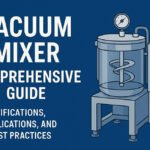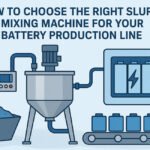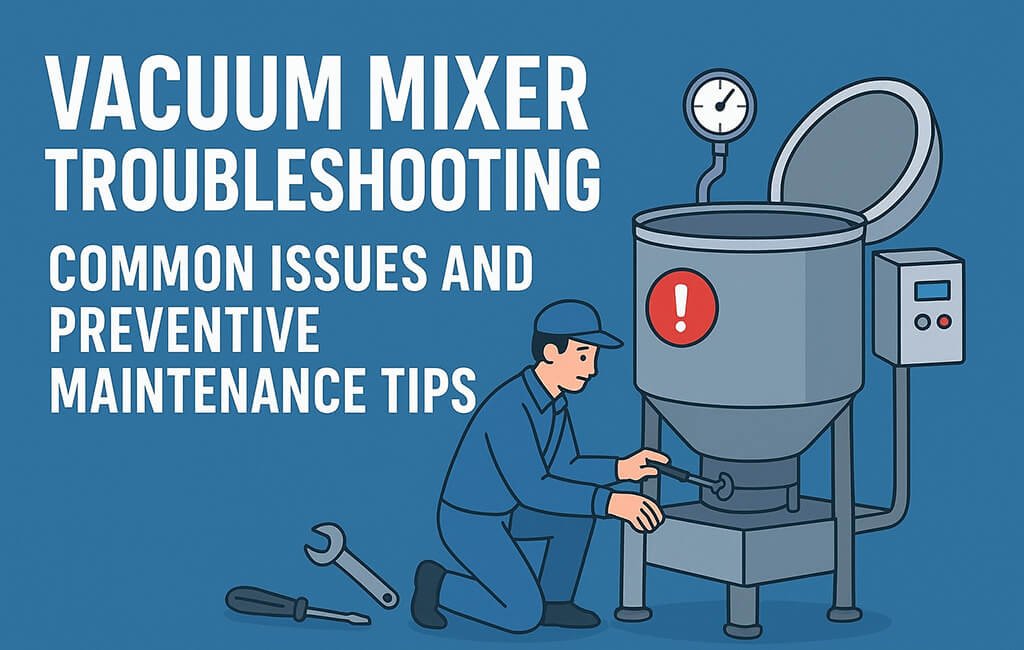Vacuum mixers serve as critical equipment in battery electrode production, where precise control of mixing parameters directly impacts coating quality and cell performance. These systems combine high-shear mixing capabilities with vacuum environments to produce homogeneous slurries while eliminating air bubbles and controlling solvent evaporation.
Effective troubleshooting and preventive maintenance of vacuum mixing equipment requires understanding both mechanical components and vacuum system dynamics. This guide provides systematic diagnostic procedures, maintenance schedules, and optimization techniques specifically tailored for battery manufacturing applications.
How Does Vacuum Level Affect Battery Slurry Mixing Quality?
Vacuum level directly influences degassing efficiency, solvent evaporation rates, and final slurry properties. Operating at 50-100 mbar typically provides optimal degassing while preventing excessive solvent loss. Higher vacuum levels enhance bubble removal but may cause unwanted evaporation of volatile components like NMP (N-Methyl-2-pyrrolidone).
Monitor vacuum stability throughout mixing cycles using calibrated pressure transducers. Fluctuations exceeding ±10 mbar indicate potential seal degradation or pump performance issues requiring immediate attention.
Critical Vacuum Mixer Components and Maintenance Requirements
Understanding component functions enables targeted troubleshooting and efficient maintenance planning. Each subsystem requires specific inspection protocols and replacement intervals based on operating conditions and material compatibility.
Vacuum System Components
The vacuum pump represents the heart of the system, typically employing rotary vane or dry screw designs for battery applications. Oil-sealed pumps require monthly oil analysis to detect contamination from solvent vapors. Dry pumps eliminate oil contamination risks but demand more frequent seal replacements.
Vacuum gauges and controllers maintain process consistency through precise pressure regulation. Capacitance manometers provide superior accuracy for critical applications, while Pirani gauges offer cost-effective monitoring for less demanding requirements.
Mixing Mechanism Elements
High-viscosity battery slurries impose significant loads on mixing blades, shafts, and bearings. Disperser blades operating at 10-30 m/s peripheral speed require monthly inspection for wear patterns indicating alignment issues. Planetary mixing systems add complexity through multiple rotation axes but provide superior homogenization.
Shaft seals prevent atmosphere ingress while accommodating rotational movement. Mechanical seals offer superior longevity compared to lip seals when handling aggressive solvents. Magnetic couplings eliminate seal requirements entirely but limit torque transmission capacity.
Comprehensive Troubleshooting Procedures
Systematic diagnostic approaches minimize downtime and prevent recurring failures. The following procedures address the most common vacuum mixer issues encountered in battery production environments.
Vacuum Loss Diagnosis
Vacuum degradation manifests through extended pump-down times, inability to reach setpoint pressure, or gradual pressure rise during operation. Begin diagnostics by isolating the mixing chamber and monitoring pressure rise rate. Acceptable leak rates remain below 0.5 mbar/minute for most battery applications.
| Leak Rate (mbar/min) | System Status | Required Action | Impact on Coating Quality |
|---|---|---|---|
| <0.5 | Acceptable | Continue monitoring | No impact |
| 0.5-2.0 | Marginal | Schedule seal inspection | Possible bubble formation |
| 2.0-5.0 | Unacceptable | Immediate maintenance | Coating defects likely |
| >5.0 | Critical | Stop production | Severe quality issues |
Perform systematic leak detection using helium mass spectrometry for precise localization. Common failure points include door seals, shaft penetrations, and instrumentation feedthroughs. Apply soap solution testing for quick field diagnostics when specialized equipment remains unavailable.
Motor Overheating Resolution
Excessive motor temperatures indicate mechanical overloading, electrical issues, or inadequate cooling. Battery slurries with viscosities exceeding 10,000 cP impose significant power requirements. Monitor motor current draw throughout mixing cycles to identify viscosity-related overloads.
Verify proper ventilation around motor housings, particularly in cleanroom environments with restricted airflow. Install temperature monitoring on motor windings to enable predictive maintenance based on thermal trending. Consider variable frequency drives for soft-start capability and overload protection.
Mixing Uniformity Problems
Non-uniform slurry properties result from inadequate mixing energy, incorrect blade selection, or improper fill levels. Perform rheological measurements at multiple sampling points to quantify homogeneity. Target coefficient of variation below 5% for critical parameters like solid content and viscosity.
Adjust blade configurations based on slurry characteristics: high-shear dispersers for initial powder wetting, followed by low-shear anchors for final homogenization. Maintain fill levels between 40-70% of vessel capacity for optimal flow patterns.
What Causes Vacuum Pump Failure in Battery Production Mixers?
Solvent vapor contamination represents the primary failure mechanism for vacuum pumps in battery applications. NMP and other electrode solvents degrade pump oil, causing viscosity changes and corrosion. Implement vapor traps and condensers upstream of pumps. Change oil monthly or when analysis indicates 10% viscosity deviation.
Particle ingestion from inadequate filtration accelerates wear of pump internals. Install appropriate filters based on slurry particle size distribution, typically 5-10 micron ratings for electrode materials.
Preventive Maintenance Scheduling
Structured maintenance programs prevent unexpected failures and extend equipment life. Adapt schedules based on production intensity, material properties, and environmental conditions.
Daily Maintenance Tasks
- Visual inspection of vacuum gauge readings and trend comparison
- Verification of cooling water flow and temperature
- Check pump oil level and color (oil-sealed pumps only)
- Monitor abnormal sounds or vibrations during operation
- Record batch parameters including vacuum level, temperature, and mixing duration
- Clean viewports and inspection windows
Weekly Maintenance Procedures
- Inspect door and shaft seals for wear or damage
- Verify calibration of critical instrumentation using reference standards
- Clean or replace inlet filters based on pressure drop measurements
- Test emergency stop and pressure relief systems
- Analyze vibration signatures for bearing condition monitoring
- Document any deviations from normal operating parameters
Monthly Maintenance Requirements
Comprehensive monthly inspections identify developing issues before failure occurs. Disassemble mixing elements for detailed wear assessment, measuring blade dimensions against specifications. Replace components showing 10% dimensional change or visible damage.
Perform vacuum pump oil analysis testing for viscosity, acid number, and particulate content. Trend results to optimize oil change intervals based on actual degradation rates rather than fixed schedules. Clean heat exchangers and cooling systems to maintain temperature control accuracy.
Annual Maintenance Overhaul
Schedule extended shutdowns for major component replacements and system upgrades. Replace all elastomeric seals regardless of condition, as material aging compromises performance even without visible degradation. Recalibrate all instrumentation against certified standards.
Perform complete vacuum system leak testing including helium leak detection on all joints and penetrations. Document baseline leak rates for future comparison. Update maintenance procedures based on failure history and technological improvements.
Optimizing Vacuum Levels for Different Battery Chemistries
Each battery chemistry requires specific vacuum parameters to achieve optimal slurry properties while preventing component degradation. The following guidelines provide starting points for process development.
| Battery Chemistry | Recommended Vacuum (mbar) | Critical Considerations | Monitoring Parameters |
|---|---|---|---|
| NMC (Lithium Nickel Manganese Cobalt) | 50-100 | Moisture sensitivity, oxidation prevention | Dew point, oxygen content |
| LFP (Lithium Iron Phosphate) | 100-200 | Lower sensitivity, focus on homogeneity | Particle size distribution |
| Silicon-based Anodes | 20-50 | Extreme moisture sensitivity, particle damage | Moisture content, viscosity |
| Solid-State Electrolytes | 10-30 | Prevent moisture absorption, maintain purity | Impedance, contamination |
Validate vacuum parameters through systematic testing of slurry properties and final electrode performance. Monitor degassing efficiency using rheological measurements before and after vacuum treatment. Target 20-30% viscosity reduction indicating successful air removal.
Contamination Control Protocols
Cross-contamination between different electrode materials severely impacts battery performance. Implement rigorous cleaning procedures adapted to cleanroom classifications and material compatibility requirements.
Cleaning Validation Methods
Establish cleaning effectiveness through surface sampling and analytical testing. Techniques include solvent rinse analysis, swab testing, and visual inspection under UV light for fluorescent materials. Set acceptance criteria based on maximum allowable carryover, typically below 10 ppm for active materials.
Document cleaning procedures including solvent types, contact times, and mechanical actions. Validate procedures for worst-case scenarios involving highest adhesion materials and maximum batch sizes. Revalidate whenever introducing new materials or modifying processes.
Solvent Compatibility Considerations
Select cleaning solvents based on material solubility and equipment compatibility. NMP effectively removes most electrode slurries but requires careful handling and vapor control. Aqueous-based slurries permit water cleaning but demand thorough drying to prevent corrosion.
Verify chemical compatibility of all wetted parts including seals, gaskets, and coatings. Replace components showing swelling, discoloration, or mechanical property changes. Maintain detailed compatibility matrices for all material combinations.
Real-Time Monitoring and Process Control
Advanced monitoring systems enable predictive maintenance and quality assurance through continuous parameter tracking. Integration with manufacturing execution systems provides comprehensive data logging and trending capabilities.
Critical Parameter Monitoring
Install redundant sensors for parameters directly impacting product quality. Vacuum pressure requires monitoring at multiple locations to detect gradients indicating flow restrictions. Temperature sensors in slurry, jacket, and bearing locations prevent thermal damage.
Implement real-time viscosity measurement using in-line rheometers or torque monitoring. Correlate mixing power consumption with slurry properties to detect formulation deviations. Set alarm limits based on validated process windows.
Data Analytics for Predictive Maintenance
Collect high-frequency data from all sensors to enable pattern recognition and anomaly detection. Machine learning algorithms identify subtle changes indicating developing failures. Examples include gradual vacuum pump efficiency decline or bearing vibration pattern changes.
Establish baseline performance metrics during commissioning for comparison throughout equipment life. Track key performance indicators including batch cycle time, energy consumption per kilogram, and first-pass quality rates.
How to Validate Mixing Homogeneity Under Vacuum?
Homogeneity validation requires multi-point sampling and comprehensive analytical testing. Extract samples from top, middle, and bottom locations plus center and wall positions. Analyze solid content, particle size distribution, and rheological properties. Target relative standard deviation below 2% for critical parameters. Vacuum conditions complicate sampling but specialized valves enable representative collection without breaking vacuum.
Perform mixing studies using Design of Experiments methodology to optimize parameters including speed, time, and vacuum level for each formulation.
Troubleshooting Checklist for Common Vacuum Mixer Issues
- ☐ Vacuum pump fails to start: Check motor overload, oil level, coupling alignment
- ☐ Extended pump-down time: Inspect door seals, perform leak test, verify pump capacity
- ☐ Excessive vibration: Check blade balance, bearing condition, mounting bolts
- ☐ Poor mixing quality: Verify fill level, blade clearance, speed settings
- ☐ Temperature control issues: Inspect coolant flow, clean heat exchanger, calibrate sensors
- ☐ Contamination detected: Review cleaning procedures, check filter integrity, validate material segregation
- ☐ Unexpected pressure rise: Test for leaks, check valve positions, monitor offgassing
- ☐ Motor overheating: Measure current draw, verify cooling, check viscosity
- ☐ Seal leakage: Inspect seal faces, verify installation, check chemical compatibility
- ☐ Control system errors: Review alarm history, check sensor connections, verify PLC program
Safety Considerations for Vacuum Mixer Maintenance
Vacuum systems present unique hazards requiring specialized safety protocols. Sudden pressure release can cause mechanical damage and injury. Always verify atmospheric pressure before opening vessels. Install redundant pressure relief devices set at 1.1 times maximum operating pressure.
Solvent exposure risks demand appropriate personal protective equipment and ventilation. Monitor atmospheric concentrations continuously when vessels remain open. Implement hot work permits for any maintenance involving ignition sources near solvent-contaminated equipment.
Lockout/tagout procedures must address both electrical and mechanical energy sources. Include vacuum isolation in standard procedures. Train personnel on gradual pressure equalization techniques to prevent implosion risks in glass components.
Conclusion
Effective vacuum mixer maintenance combines systematic troubleshooting procedures with proactive preventive measures tailored to battery production requirements. Understanding the interdependencies between vacuum system performance, mixing efficiency, and final coating quality enables optimization of both equipment reliability and product consistency.
Regular implementation of these maintenance protocols, coupled with real-time monitoring and predictive analytics, minimizes unplanned downtime while extending equipment service life. As battery chemistries continue evolving, maintenance strategies must adapt to address new material challenges while maintaining the fundamental principles of vacuum system care and mixing process control.
Glossary
- Degassing
- Process of removing dissolved or entrained gases from liquids under vacuum to prevent bubble formation in coated electrodes
- NMP (N-Methyl-2-pyrrolidone)
- Common organic solvent used in electrode slurry preparation, requiring careful handling due to toxicity and hygroscopic nature
- Mechanical Seal
- Rotating seal design using precisely machined faces to prevent atmosphere ingress while accommodating shaft rotation
- Cleanroom Classification
- Standardized system defining maximum allowable particle concentrations for contamination-sensitive manufacturing environments
- Rheology
- Study of flow and deformation characteristics of materials, critical for optimizing electrode slurry coating properties
- Capacitance Manometer
- High-accuracy pressure measurement device using diaphragm deflection, ideal for vacuum process control
- Planetary Mixing
- Mixing action combining rotation and revolution motions to achieve superior homogenization of high-viscosity materials
- Vapor Trap
- Device preventing solvent vapors from entering vacuum pumps through condensation or chemical absorption



